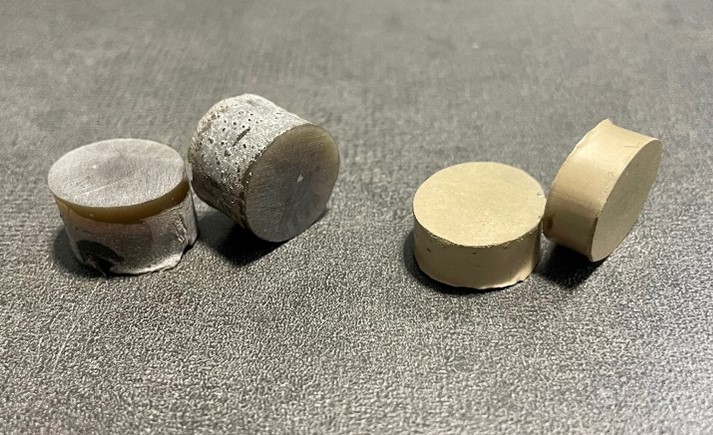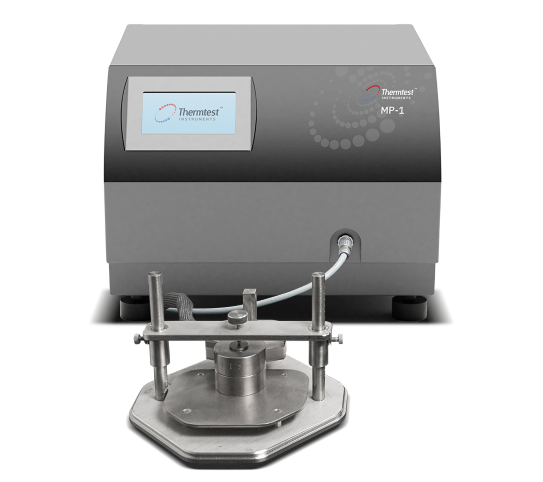Join us at the International Thermal Conductivity Conference (ITCC) and the International Thermal Expansion Symposium (ITES).
Geological
Nanomaterials
Pastes
Pastes
Polymers
Epoxy is a thermosetting resin or adhesive that is used in a wide variety of applications. Thanks to its high strength, chemical and corrosion resistance, and excellent adhesion to a variety of surfaces it is useful in many different industries. Epoxies typically have very low thermal conductivity and are electrically insulating which makes them excellent insulators in electronics. However, the properties of epoxies can be modified with added fillings such as ceramic, metallic, carbon fiber and more. But how do these added fillers also affect the thermal conductivity of the epoxies?
Two samples of epoxy resin, Loctite® AA H4500 and PRIMA-SOLDER™ (EG8020) were measured for thermal conductivity (W/m-K), thermal diffusivity (mm²/s), and volumetric specific heat (MJ/m³K) using the MP-1 Transient Plane Source (TPS) Method: Standard Module. The MP-1 with TPS Standard Module is used to measure the average or bulk thermal conductivity and thermal diffusivity of isotropic materials.
Epoxy is a term that can refer to a synthetic polymer, a resin, or an adhesive. Epoxies exhibit desirable mechanical and thermal properties, low shrinkage during curing, as well as high chemical and corrosion resistance. They are often used as paints and coatings, adhesives, and in electrical systems.
In this application we are measuring two different types of epoxy: Loctite® AA H4500 and PRIMA-SOLDER™ (EG8020). Loctite® AA H4500 is a two-part unfilled adhesive epoxy that forms very strong bonds and maintains its strength over a range of temperatures. PRIMA-SOLDER™ is a two-part silver-filled epoxy that also has strong bond strength and is electrically and thermally conductive (figure 1).

Figure 1. Loctite® AA H4500 (right) and PRIMA-SOLDER™ (left).
The MP-1 is designed to test the absolute thermal conductivity, thermal diffusivity and specific heat of solids, liquids, pastes and powders with the powerful combination of the transient plane source (TPS, ISO 22007-2) and transient hot-wire (THW, ASTM D7896-19) methods.
When making measurements using the Transient Plane Source (TPS) method, it is important to select an appropriate sensor size to stay within the available probing depth of the sample, as well as to satisfy Total to Characteristic Time (TCT). If the sensor is too small or large for the sample, the measurements may not be as sensitive when measuring the thermal properties.
With the Automated Sensor Selection feature, the MP-1 recommends the appropriate sensor to use based on the dimensions of the sample. The 2117-1 sensor was selected in order to satisfy the TCT of the smaller sample size of the epoxy.

Figure 2. Measurement Platform-1 (MP-1) with room temperature TPS stand.
In this application, two samples of epoxy, Loctite® AA H4500 and PRIMA-SOLDER™ (EG8020), were measured for thermal conductivity (W/m·K), thermal diffusivity (mm2/s), and volumetric specific heat (MJ/m3K) using the MP-1. Curing epoxy resin is a process of transforming the liquid into a solid by triggering a chemical reaction. Both epoxies are room temperature curable adhesives and were cured at room temperature for 24 hours.
The epoxy samples were measured in the symmetric configuration using the 3.2 mm radius double spiral TPS sensor (2117-1). The intelligent transient plane source (iTPS) feature was used to determine the appropriate power and test time to use for each sample. Optimal measurement parameters of 5s and 100mW were determined for the unfilled Loctite® epoxy, and 2s and 200mW for the PRIMA-SOLDER™ silver filled epoxy.
Table 1. Thermal properties of unfilled (Loctite® AA H4500) and silver filled (PRIMA-SOLDER™ (EG8020)) epoxy samples measured with the MP-1 at 23°C.
| Sample | Thermal Conductivity (W/m·K) | Thermal Diffusivity (mm2/s) | Volumetric Specific Heat (MJ/m3K) |
| Loctite® AA H4500 | 0.200 | 0.117 | 1.717 |
| PRIMA-SOLDER™ (EG8020) | 1.905 | 1.849 | 1.030 |
n=5, 3.2 mm (2117-1), 23ᵒC. 5s, 100mW (unfiled epoxy), 5s, 200mW (silver filled epoxy).
Epoxy is highly versatile and extremely strong. There are many different types of epoxies that are used for different applications. The addition of fillers to epoxies can change their mechanical, tensile and thermophysical properties, affecting what applications they are used for. The silver filled PRIMA-SOLDER™ (EG8020) epoxy has a much higher thermal conductivity than Loctite® AA H4500 epoxy as seen in this application.
Reference:
PRIMA-SOLDER™ (EG8020) 1/2 Ounce Kit (1/4 oz part A and part B) – AI Technology, Inc.
LOCTITE AA H4500 – Structural adhesive – Henkel Adhesives (henkel-adhesives.com)